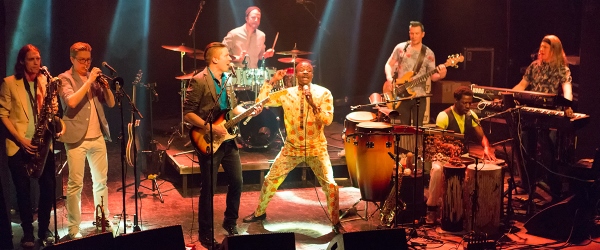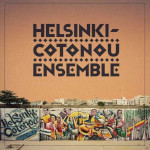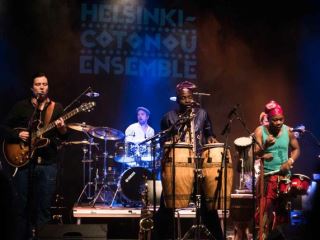

Formed in Benin a decade ago, Helsinki-Cotonou Ensemble faced big logistical challenges in creating their fifth album last year. Despite its tough beginnings, the resulting disc is a sunny summer funk party blending African, European and American influences.
Known as a sweaty, crowd-pleasing live band, Helsinki-Cotonou Ensemble’s roots go back to 2009. That’s when Finnish guitarist Janne Halonen went to West Africa to study Benin’s mysterious Voodoo rhythms. The tradition has influenced Beninese stars such as Angelique Kidjo and jazz guitarist Lionel Loueke, who helped Halonen connect with local musicians.
While there, Halonen learned from and collaborated with charismatic Beninese singer and percussionist Noël Saïzonou, who visited Finland in 2011. Halonen and Saïzonou invited bassist Sampo Riskilä and drummer Juha Räsänen to form the core of the band, which blends Afrobeat, highlife, jazz, soul and r&r into a heady, horn-driven mix.
Internet Filesharing Ensemble
In early 2012 the three Finns went to Benin where they set up the band with Saïzonou and other local musicians, playing several gigs and recording most of their debut album, "Beaucoup de Piment!". It was released the following year, backed by a Finnish tour. Since then, the eight-man Finnish-Beninese band has toured on four continents and released five albums, the latest, self-titled, collection appearing in late May.
What might have just been a one-off experiment has lasted a decade and survived many challenges including label changes, visa delays and red tape – and of course Covid, which has made collaborating tough even for musicians in the same city, let alone on distant continents. The pandemic forced main songwriters Saïzonou and Halonen to invent a new way of working, replacing face-to-face jam sessions with virtual file-sharing.

“The writing process was very different this time,” says Halonen. “We had planned to write and record in Helsinki last summer, but of course Noël had to cancel his trip. So we decided to do it via Zoom and sending files, which was completely new for him.” By September, the two had about 20 minutes’ worth written and arranged. “The band went into the studio here in Helsinki and basically recorded side A, which is meant to be listened to together without breaks,” says Halonen. “In December we recorded side B, and in January Sampo and I went to Benin and recorded Noël’s vocals and percussion parts.”
1970s retro vibes
Though the album was recorded in three countries over a six-month period, it doesn’t sound stitched-together. On the contrary, it’s their most seamless, consistent album yet. Many of the tracks on side A have a lilting, easy-going retro sound that brings to mind ‘70s soul, R&B and disco classics – reiterating the mutual musical influences floating between Africa, North America and Europe. “We were kind of going for a more organic ‘70s sound like on our first record, "Beaucoup de Piment!", but that was mostly recorded in Benin, and the retro vibes we were digging at that time were a little different from now."
Besides West African sounds and Motown, these might include jazzy, funky horn-laden bands such as Steely Dan and Tower of Power. The first single, Min He Mon Ébgé – The One Who Sees Today, is classic HCE: a breezy, feel-good track that also shows off advanced musical and compositional skills. The video was produced in Cotonou, Benin's largest city, and features a mural there depicting the band, which also appears on the album cover.
More composers in the mix

There were more composing contributions from other group members this time, including the newest addition, Tanzanian percussionist, vocalist, trombonist and dancer Kasheshi Makena. “The last song on the album, the ballad Do Akon Kpikpan - Stay Strong was based on a sketch that Kasheshi wrote,” says Halonen, whose long pensive guitar solo that brings to mind Hasse Walli, another Finn who has long collaborated with West African musicians. “I wrote a page of music with a melodic motif and a bit of a harmonic palette and asked everyone in the band who writes music to write small ideas based on that, not spending more than an hour on each one. Noël and I used those as background material. So the album was written remotely but practically everybody had a chance to participate in the process,” Halonen explains.
Also collaborating virtually was Synik, a Zimbabwean rapper based in Lisbon who provides this album’s only lyrics in English (Saïzonou mostly sings in the Gun language of Benin and Nigeria). “Sampo heard Synik’s demo and we decided he would fit in perfectly. We did the whole project through Messenger, and it went really well even though we didn’t know each other – it was all about the music. And after that collab, I ended up producing three tracks for his upcoming record. He’s a really sweet guy and a wonderful lyricist. I’m really looking forward to hanging out with him in Lisbon once the pandemic is over,” says Halonen.

The track featuring Synik, The Craft, could be a popular live number, combining jazzy horns and piano with hip-hop in a style reminiscent of festival favourites Ricky-Tick Big Band, whose baritone saxophonist Linda Fredriksson has also played with HCE.
Mamba’s studio magic
Halonen, who arranged and produced all the tracks, says that the album’s smoother, more consistent sound is largely thanks to recording engineer Abdissa “Mamba” Assefa, who also added percussion. This Ethiopian-born drummer has played with bands such as The Rasmus, Bomfunk MCs, Brand New Heavies, RinneRadio, and runs Ambience Studios in Helsinki. “Mamba is a great recording engineer and has a lot of interesting old gear. It was so much fun to work there. When we plugged in and started playing with his miking, pre-amps and approach to recording, that was pretty much the sound that you hear on the record. The credit goes to Mamba for that nice smooth soundscape on the record.”
Halonen recorded Saïzonou’s vocals and percussion in Benin, encouraging him to try different techniques. “When we recorded his vocals, we did a lot more experimenting in terms of dynamics and phrasing and so on. Before, we’ve basically just turned the mic on and he’s done them in one or two takes. We spent more time on the vocals this time and I think that developed both of us in terms of discovering new sounds and new ways of interpreting our music.” Saïzonou’s singing does sound more varied, stronger and smoother on the record – but he’ll surely show his rowdier, rawer side onstage – where the band hopes to return soon after a two-year break.
In July and August, the band is scheduled to tour Finland, beginning at the Kaustinen Folk Music Festival. “Fingers crossed,” says Halonen. “Let’s hope the borders open so Noël can get here!”
The article has originally been published @
MusicFinland.com, June 2021,
a showcase in English for Finnish musical culture since 1985.
Photo Credits:
(1)-(5) Helsinki-Cotonou Ensemble,
(6) Finnish Music Quarterly / Music Finland (unknown/website).